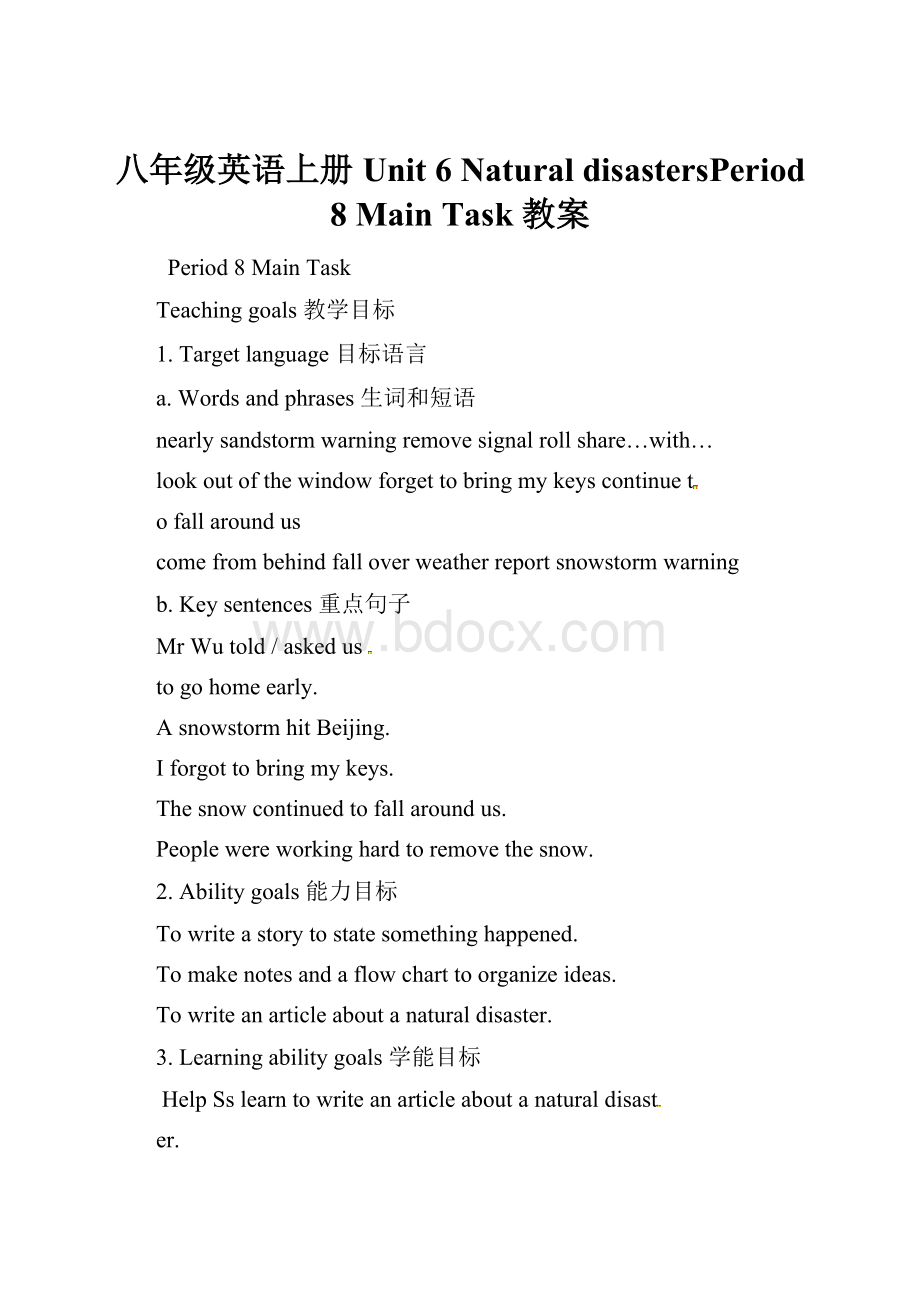八年级英语上册 Unit 6 Natural disastersPeriod 8Main Task 教案.docx
《八年级英语上册 Unit 6 Natural disastersPeriod 8Main Task 教案.docx》由会员分享,可在线阅读,更多相关《八年级英语上册 Unit 6 Natural disastersPeriod 8Main Task 教案.docx(12页珍藏版)》请在冰豆网上搜索。

八年级英语上册Unit6NaturaldisastersPeriod8MainTask教案
Period8MainTask
Teachinggoals教学目标
1.Targetlanguage目标语言
a.Wordsandphrases生词和短语
nearlysandstormwarningremovesignalrollshare…with…
lookoutofthewindowforgettobringmykeyscontinuet
ofallaroundus
comefrombehindfalloverweatherreportsnowstormwarning
b.Keysentences重点句子
MrWutold/askedus
togohomeearly.
AsnowstormhitBeijing.
Iforgottobringmykeys.
Thesnowcontinuedtofallaroundus.
Peoplewereworkinghardtoremovethesnow.
2.Abilitygoals能力目标
Towriteastorytostatesomethinghappened.
Tomakenotesandaflowcharttoorganizeideas.
Towriteanarticleaboutanaturaldisaster.
3.Learningabilitygoals学能目标
HelpSslearntowriteanarticleaboutanaturaldisast
er.
Teachingimportantanddifficultpoints教学重难点
Towriteanarticleaboutanaturaldisaster.
Teachingaids教具准备
Multi-Media.
Teachingproceduresandways教学过程与方式
StepILead-in
ReviewthepassageaboutTimmy’sstory.Askeachstudenttosayonesentencelikethis:
S1:
Timmywasdoingshoppingwhentheearthquakestarted.
S2:
Hefeltaslightshakingthroughhisbody.
S3:
Peoplewereveryfrightened.
S4:
Theyheardthegreatnoiselikebombs.
S5:
Theearthbegantoshake.
…
Iftheydon’tmentionsomeimportantinformation,Icanraisesomequestionstoremindthem.
T:
Whathappenedtothewallsofthebuilding?
DidTimmyrunoutofthebuilding?
…
StepIIPresentation
ThisactivityhelpsSswriteanarticleaboutanaturaldisasterbymakingnotesandaflowchat.
T:
Ifyouwanttotellyourfriendsaboutanaturaldisasterinwriting.You’dbetterorganizeyourideasfirst.Howdoyouorganizeinformationweneed?
Firstly,youshouldmakesomenotesab
outthefacts.Secondly(write“1.Makesomenotes”ontheBb),youshouldm
akeaflowcharttoorganizethesenotes(write“2.Makeaflowchart”ontheBb).Inthisway,otherswillunderstandyourarticlewell.Thereisanexampleonpage105.Let’sseeit.
1.Havestudentsreadthenotesanddiscussthemeaningofeachone.RemindtheSsthatsomewordsareomittedtomakeanoteconcise.
Explain:
1)tell/asksb(not)todosth.叫某人(不)做某事
Mothertoldmetobringanumbrellawithmebecauseitmightrain.
2)sharesthwithsb.和某人合用某物
SandylefthisEnglishbookathometoday,soIhadtosharemyEnglishbookwithhim.
3)hit—hit撞击;袭击
AearthquakehitTaiwanin1999.
4)continuetodosth.继续做某事
Theycontinuedtoworkuntil9:
00p.m.yesterday.
5)removesnow清除积雪
MyclassmateswereremovingsnowwhenIgottoschool.
6)lookoutofthewindow向窗外看
Don’tlookoutthewindowinclass.
2.AskSstocompletePartB,thenchecktheanswers.Remindthemthattheflowcharttellsusthatwhenwewriteanarticleaboutanaturaldisaster,weusuallywritethreeparts:
Introduction/Duringthedisaster/Afterthedisast
er.(writethesethreephrasesontheBb).
3.HavesomeSsaskandanswerinpairsaccordingtotheflowchartlikethis:
S1:
Whathappened?
S2:
AsnowstormhitBeijing.
S3:
Whendidithappen?
S4:
ItwasFriday,28thJanuary.
…
4.GetSstoscanPartCandfindwhichparagraphsmatchwhichpartsintheflowchart.Thencompleteit.
5.AsksomeindividualSstoreadthearticleandchecktheanswers.Thenreaditinchorus.
StepIIIWriting
ThisactivitypracticestheSs’writingskills.
1.AskSstoreadthroughPartD,letthemchooseatopic.Iftheythinkitdifficult,askthemtousestoryinIntegratedskills,buttheymustimaginehe/shewasinthecartoo.
2.AskthemtodrawaflowchartlikePartBbeforewriting.Theteacheroffershelpbywalkingaroundtheclass.
3.AskseveralSstoreadtheirarticlestotheclass.Correctthemistakewhichinfluencestheexpressingoftheideas.
StepIVHomework
Finishtheexercisesinexercisebook.
Period9Checkout
Teachinggoals教学目标
1.Targetlanguage目标语言
Wordsandphrases生词和短语
situationsoldierthepeopleinneedgiveoutfoodcleandrinkingwater
theterriblesituationsocialworkers
2.Abilitygoals能力目标
Topracticeusingthepastcontinuoustense.
Toreviewkeyvocabularyfordescribingnaturaldisasters.
3.Learningabilitygoals学能目标
HelpSsreviewwhattheylearntintheunit.
Teachingimportantanddifficultgoals教学重难点
Topracticeusingthepastcontinuoustense.
Teachingaids教具准备
Somepicturesaboutbadweather,Multi-Media.
Teachingproceduresandways
教学过程与方式
StepIRevision
Showsomepicturesaboutbadweather(likethepicturesonpage93)forSstosaysomesentencesusingthepastcontinuoustensewith“when”and“while”clause
Samples:
1.Theboywaswalkinghomewhenthetyphooncame.
2.Thegirlwasdoinghomeworkinherbedroomwhenthethunderandlightn
ingcame.
3.Amanandawomanwerewalkinginthewaterwhileitwasraining.
4.Iwasdoinghomeworkwhileitwassnowingheavily.
StepIIExercises(A,B)
Thisactivityhelpsrevisethepastcontinuoustense.
1.ExplainthecontextinPartA,andletthemcompleteit.AsksomeSstoreadinpairsandchecktheiranswers.
Explain:
Soldierswerehelpingpeoplegetoutfromunderallthestonesandbricks.
战士在帮人们从石块和砖头下面出来。
socialworkers社会工作者
peopleinneed需要帮助的人们
terriblesituation可怕的情况
cleandrinkingwater干净的饮用水
2.HaveSsreadinpairsandthenaskandanswerinpairs.
Sample:
S1:
WhatwasMilliedoinginthelibraryyesterday?
S2:
Shewaslookingforavideoaboutearthquake.
S1:
Didshefindone?
S2:
Yes.
S1:
Wheredidtheear
thquakehappen?
S2:
InTangshan.
S1:
Whatdidshesee?
S2:
Thevideoshowstheterriblesituationandsoldiersandmanysocialworkerswerehelpingpeopleinneed.
3.CompletePartB,checktheanswerswiththeirpartners,thenaskindividualSstoreadoutthewordstotheclass.
StepIIIConsolidation
Domoreexercisetoconsolidatethewordsandgrammarinthisunit.
一、根据首字母或汉语提示及句意写出单词。
1.Theylookedateachotherinf______(feelingofbeingfrightened)whentheysuddenlyheardabignoise.
2.Manypeopleweret______(keptinaplaceandcouldn’tleave)intheburningbuilding.
3.Peopleranw______(inawaywithoutcontrol)aspiecesofglassandbricksfelldown.
4.Theschoolfootballteamhasl______(tofailtowinsth.)thegame.
5.Didyouhearsomepeoples______(shoutloudly)forhelp?
6.Thecar______(事故)killedmanypeople.
7.There’sno______(借口)forbeinglate.
8.Myfriends______(建议)metobuyacomputeryesterday.
9.The______(气温)issolowthatyou’dputonyourcoat.
10.His______(到达)makesmehappy.
二、用所给词或词组的正确形式填空
wash…away,inalldirections,not…anymore,natural,tryone’sbest,hit,lookafteroneself,be
1.Theflood______manyhousesandtrees______.
2.Thebabyistooyoungto______.
3.It
’simportantforustokeepthebalanceof______.
4.There______nohospitalsaroundheretwentyyearsago.
5.Whenth
efilmwasover,peopleleft______.
6.Thebabysawhermotherand______cry______.
7.Weshould______tolearnEnglishwell.
8.Fatherwasveryangryand______meonthehead.
StepIVHomework
1.Finishtheexercisesinexercisebook.
2.Reviseallwordsandphrases,andgrammarinthisunit.
教学资源库
I.背景知识:
台湾大地震发生在1999年9月21日凌晨一点四十七分。
地震的震中在台北市西南方150公里处南投县的集集镇,震级为里氏7.6级,当时大多数人都在睡梦中。
据报道在台北市人口密集地区有人员伤亡、建筑物倒塌和其他损坏现象。
在些次地震中有1,700多人死亡,8,700多人受伤,12,000座建筑物遭受破坏,100,000人无家可归。
据信这是台北上个世纪最严重的一次地震。
II.Languagepoints
1.ItoldmyselfthatImuststayalive.
stayalive=bealive活下去stay是系动词,意思是“保持…状态”,和形容词连用。
e.g.Ifyouwanttostayhealthy,eatmorevegetablesandlessmeat.
2.Peoplewereinagreathurrytomoveawaythebricksandstones.
inahurry赶紧;匆忙,相当于hurriedly。
如:
Iwenttoschoolinahurryandleftmytextbookhome
=Iwenttoschoolhurriedlyandleftmytextbookhome.
moveaway意为“搬走,离开“的意思。
如:
Hemovedthetableawayfromthewindow.
拓展词组:
moveback退缩moveon继续前进movein搬入moveout迁出
3.Weshoulddonothingbutwalkslowlyinthestorm.
nothingbut表示“除了……之外什么也不”如:
Wecouldseenothingbutwater.
benothingtosb./sth.对……不算什么,毫无关系如:
Bothmoneyandhonorwerenothingtohim.
donothingbutdo…只做……如:
Shedoesnothingbutlistentorecords.
4.MrWutoldustogohomeearly.
tellsb(not)todosth.叫某人(不要)做某事
e.g.Mothertoldusnottostayouttoolate.
5.because,as,since的区别
because多表示所叙述的理由是复合句的重点,所以它引导的从句常用于回答疑问的直接理由。
如:
WhyamIleaving?
I’mleavingbecauseIwantto.
as,since用于表示理由是已知,而理由以外的
内容才是叙述的重点,两个连词引出的句子常置于主句前。
since侧重形式,as多表示理由以外的内容才是重点。
如:
(1)Asitisrainy,let’sstayathome.
(2)Sinceyouhavenolicense,youarenotallowedtodrive.
注意:
for引导的句子不置于主句前,用于补充说明理由。
如:
Iwillfollowhisadvice,forheisadoctor.
III.Grammar
(一)过去进行时:
pastcontinuoustense
1.现在进行时和过去进行时这两个时态的动词在形式上都是由“be+现在分词”构成,只是过去进行时表示过去某一时刻或某一段时间正在发生的动作,因此be动词由was,were代替现在进行时中的助动词am,is,are。
2.过去进行时的构成:
只要把现在进行时中的am/is/are改成它们的进去式was/were就行了。
肯定句:
主语+was/were+现在分词+…
否定句:
主语+was/were+not+现在分词+…
疑问句:
Was/Were+主语+现在分词+…?
3.进去进行时的用法:
(1)表示过去某一时刻正在进行的动作。
这时常和atthis/thattime,thistimeyesterday,atsixlastSunday等时间状语连用。
e.g.HewaswatchingTVthistimeyesterday.昨天这个时候他正在看电视。
Theyweresweepingtheflooratfouryesterdayafternoon.
昨天下午四点他们在扫地。
(2)表示过去某一段时间内正在进行的动作。
这种用法往往也有具体的时间状语,或与另一个动作相对应。
常与fromseventoelevenyesterdaymornin
g,thewholeevening等状语或以when,while引导的时间状语连用。
e.g.Whatwereyoudoingfromtwotothreeyesterdayafternoon?
昨天下午2点到3点你在干什么?
Itwasrainingallyesterdayevening.昨天整个晚上都在下雨。
Whentheycamein,weweredoingourhomework.
当他们进来时,我们正在做作业。
MyfatherwaswatchingTVwhilemymotherwascooking.
我爸爸在看电视而我妈妈在做饭。
4.过去进行时与一般过去时的区别:
一般过去时强调事情的结果,已经过去了;而过去进行时更强调事情进行的状态,不一定做好了。
过去进行时与一般过去时的区别
(1)进行时表某一行为的“片断”一般时表示行为的“整体”和存在的状态。
Iwasreadingtheb